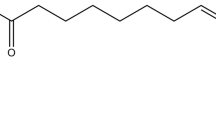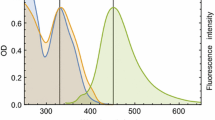Abstract
Tryptophan 214, the only tryptophan residue in human serum albumin, is located in the physiologically important subdomain 2A ligand binding site. In the present study the fluorescence lifetime of tryptophan 214 in the following human serum albumin (HSA) mutants with substitutions in subdomain 2A were determined: K195M, K199M, F211V, R218M, R218H, R218A, R222M, H242V, and R257M. An HSA mutant in which tryptophan was moved from subdomain 2A to subdomain 3A (W214L/Y411W) was also examined. Additionally, the fluorescence lifetime of tryptophan 214 in an HSA fragment consisting of subdomains 1A, 1B, and 2A (1A-1B-2A HSA) was determined. For those species expected to have the most dramatic changes in tryptophan microenvironment, W214L/Y411W and 1A-1B-2A HSA, clear changes in tryptophan lifetimes were observed. Significant changes were also seen for those species with mutations at position 218, which is next to tryptophan in the X-ray structure of HSA. However, significant changes were also observed for H242V and R257M, which contain substitutions at positions not immediately adjacent to tryptophan 214, highlighting the conformational flexibility of subdomain 2A.
Similar content being viewed by others
References
Petersen, C. E., Ha, C. E., Harohalli, K., et al. (1997) Mutagenesis studies of thyroxine binding to human serum albumin define an important structural characteristic of subdomain 2A. Biochemistry, 36, 7012–7017.
Petersen, C. E., Ha, C. E., Jameson, D. M., et al. (1996) Mutations in a specific human serum albumin thyroxine binding site define the structural basis of familial dysalbuminemic hyperthyroxinemia. J. Biol. Chem. 271 19110–19117.
Petersen, C. E., Ha, C. E., Harohalli, K., et al. (2000) A dynamic model for bilirubin binding to human serum albumin. J. Biol. Chem. 275, 20985–20995.
Petersen, C. E., Ha, C. E., Curry, S., et al. (2002) Probing the structure of the warfarin-binding site on human serum albumin using site-directed mutagenesis. Proteins 47, 116–125.
Helms, M. K., Petersen, C. E., Bhagavan N. V., et al. (1997) Time-resolved fluorescence studies on site-directed mutants of human serum albumin. FEBS Lett. 408, 67–70.
Hazan, G., Haas, E., and Steinberg, I. Z. (1976) The fluorescence decay of human serum albumin and its subfractions. Biochim. Biophys. Acta 434, 144–153.
Lakowicz, J. R., Jayaweera, R., Szmacinski, H., et al. (1989) Resolution of two emission spectra for tryptophan using frequency-domain phase-modulation spectra. Photochem. Photobiol. 50, 541–546.
Kasai, S., Horie, T., Mizuma, T., et al. (1987) Fluorescence energy transfer study of the relationship between the lone tryptophan residue and drug binding sites in human serum albumin. J. Pharm. Sci. 76, 387–392.
Munro I., Pecht, I., and Stryer, L. (1979) Subnanosecond motions of tryptophan residues in proteins. Proc. Natl. Acad. Sci. USA 76, 56–60.
Lakowicz, J. R. and Gryczynski, I. (1992) Tryptophan fluorescence intensity and anisotropy decays of human serum albumin resulting from one-photon and two-photon excitation. Biophys. Chem. 45, 1–6.
Vos, K., van Hoek, A., and Visser, A. J. (1987) Application of a reference convolution method to tryptophan fluorescence in proteins. A refined description of rotational dynamics. Eur. J. Biochem. 165, 55–63.
Marzola, P. and Gratton, E. (1991) Hydration and protein dynamics: frequency domain fluorescence spectroscopy on proteins in reverse micelles. J. Phys. Chem. 95, 9488–9495.
Siemiarczuk, A., Wagner, B. D., and Ware, W. R. (1990) A comparison of the maximum entropy and exponential series methods for recovery of distributions of lifetimes from fluorescence decay data. J. Phys. Chem. 94, 1661–1666.
Petersen, C. E. Ha, C. E., Mandel, M., et al.(1995) Expression of a human serum albumin variant with high affinity for thyroxine. Biochem. Biophys. Res. Commun. 214, 1121–1129.
Eckenhoff, R. G., Petersen C. E. Ha, C. E., et al. (2000) Inhaled anesthetic binding sites in human serum albumin. J. Biol. Chem. 275, 30439–30444.
Glatz, J. F. and Veerkamp, J. H. (1983) Removal of fatty acids from serum albumin by Lipidex 1000 chromatography. J. Biochem. Biophys. Methods 8, 57–61.
Szabo, A. G. and Rayner, D. M. (1980) Fluorescence decay of tryptophan conformers in aqueous solution. J. Am. Chem. Soc. 102, 554–563.
James, D. R., Liu Y.-S., Siemiarczuk, A., et al. (1988) Recovery of underlying distributions of lifetimes from fluorescence decay data II. Proc. Soc. Photo-optical Instrument. Eng. 909, 90–94.
Merola, F., Rigler, R., Holmgren A., et al. (1989) Picosecond tryptophan fluorescence of thioredoxin: evidence for discrete species in slow exchange. Biochemistry 28, 3383–3398.
Wahl, P. and Auchet, J. C. (1972) [Resolutions of fluorescence spectra using the decay measurements. Application to the study of human serum albumin]. Biochim. Biophys. Acta 285, 99–117.
Author information
Authors and Affiliations
Corresponding author
Rights and permissions
About this article
Cite this article
Siemiarczuk, A., Petersen, C.E., Ha, CE. et al. Analysis of tryptophan fluorescence lifetimes in a series of human serum albumin mutants with substitutions in subdomain 2 A. Cell Biochem Biophys 40, 115–122 (2004). https://doi.org/10.1385/CBB:40:2:115
Issue Date:
DOI: https://doi.org/10.1385/CBB:40:2:115




